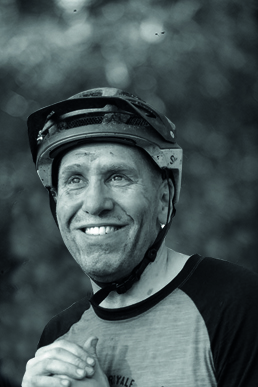In the past few years, budget full-suspension mountain bikes have improved to the extent that a small number now deliver sorted performance for not much over £1,000.
The Boardman MTR 8.6 is a case in point. Its modern geometry and sizing equate to trail bikes costing way more cash. While some of its equipment may be cheap, it’s fundamentally up to the job.
Previously, when looking for a mountain bike at home on proper trails, your options would have been a front-suspension only bike with a superior parts spec – such as the other Boardman machine on test, the MHT 8.9 hardtail.
The reason being brands always struggled to spec forks, brakes, gears and tyres capable of hacking it on modern man-made trails because they had to foot the additional cost of pivots, linkages and rear shocks.
Balancing budgets between spec and suspension also tipped the scales in the wrong direction for efficient climbing. This frequently resulted in bikes with poor-quality parts unable to keep pace with aggressive or racier riders.
On top of kit compromises, budget hardtail mountain bikes seemed slower to move on from old-fashioned angles and cockpit setups than many contemporary hardtails.
This meant they didn’t benefit from recent advances in handling, ushered in by calmer-feeling, more relaxed geometry and more precise steering.
Far too many cheap full-suspension mountain bikes still had narrow handlebars, long stems, steep head angles and short reaches. Conversely, the confidence-inspiring kit and measurements on modern trail bikes keep you safe and egg you on for the fun stuff.
Thankfully, the Boardman MTR 8.6 tested here kicks this outdated attitude into touch. Its bang up-to-date shape is ready to go toe-for-toe on any terrain or trail types with its better-equipped MHT stablemate.
What you’ll want to know, though, is whether, at roughly the same price, the hardtail – benefitting from cash saved on the frame and reflected in some higher-quality parts – makes for a better all-rounder than a machine with bump-absorbing suspension at both ends.
We reckon the answer to this depends on the kind of riding you enjoy, so read on to find out.
Hardtail mountain bike
Boardman MHT 8.9
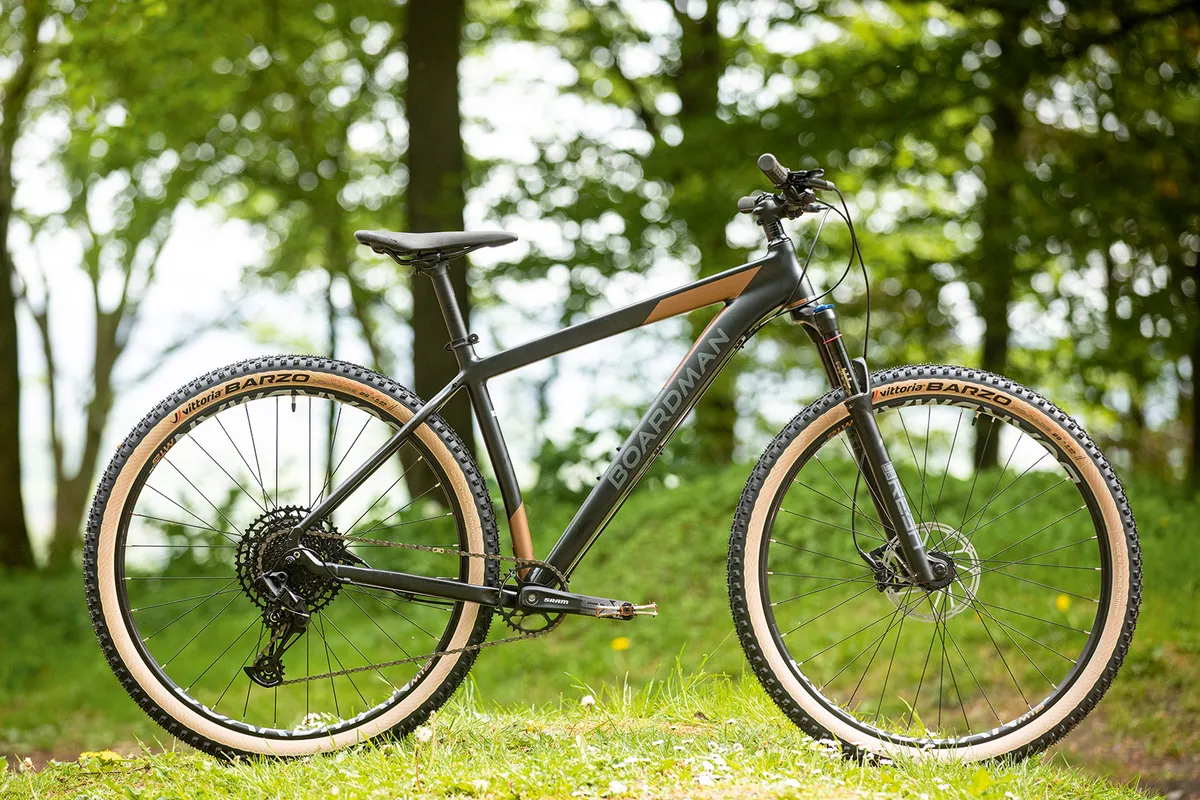
- Retro ride: The bronze-and-black colour scheme and gumwall tyres look the business, but the aesthetics are spoiled by the old-school SRAM PowerSpline BB with its exposed plastic shell
- Slippery devils: Vittoria’s Barzo tyres roll fast but aren’t the grippiest in challenging conditions
- Forked up: While the RockShox Reba is an alright budget fork, Boardman have gone with the largest available offset (51mm), which reduces fork trail (a stabilising force on steering), places the front-wheel axle further out in front and increases the bike’s twitchy steering feel
Boardman’s top-tier hardtail looks fantastic in a retro colourway with gumwall tyres. With a lightweight aluminium frame, the 8.9 is designed to walk the line between trail and cross-country, with a 120mm-travel fork and wide-range 12-speed gearing.
Components are generally a step up from those on its full-suspension sibling, with the money saved by not having a rear shock and complicated machined parts being put back into better equipment.
The top-value Boardman MHT 8.9 is no slouch, either, but unless you live purely for climbing and fitness challenges, a hardtail with more slacked-out angles will likely suit you better.
Boardman MHT 8.9 specifications
- Sizes: S, M, L (tested)
- Weight: 13.3kg, large size without pedals
- Frame: Smooth-welded 6061 aluminium alloy
- Fork: RockShox Reba RL, 120mm travel
- Drivetrain: SRAM SX Eagle (1x12)
- Wheelset: Boardman MTR rims on Formula hubs
- Tyres: Vittoria Barzo TLR Graphene 2.0 29x2.5in
- Brakes: SRAM Level T, 180/160mm rotors
- Bar: Boardman, 780mm
- Stem: Boardman, 45mm
- Seatpost: Boardman rigid
- Saddle: Boardman MTH
- Price: £1,050
Boardman MHT 8.9 geometry
| | S | M | L |
|---|---|---|---|
| Seat angle (degrees) | 74 | 73.5 | 73.5 |
| Head angle (degrees) | 68 | 68 | 68 |
| Chainstay (mm) | 435 | 435 | 435 |
| Seat tube (mm) | 410 | 460 | 483 |
| Top tube (mm) | 586 | 610 | 630 |
| Head tube (mm) | 100 | 100 | 115 |
| Fork offset (mm) | 51 | 51 | 51 |
| Bottom bracket drop (mm) | 63 | 63 | 63 |
| Stack (mm) | 625 | 625 | 639 |
| Reach (mm) | 407 | 425 | 441 |
| Crank length (mm) | 170 | 175 | 175 |
| Handlebar width (mm) | 720 | 740 | 740 |
Full-suspension mountain bike
Boardman MTR 8.6
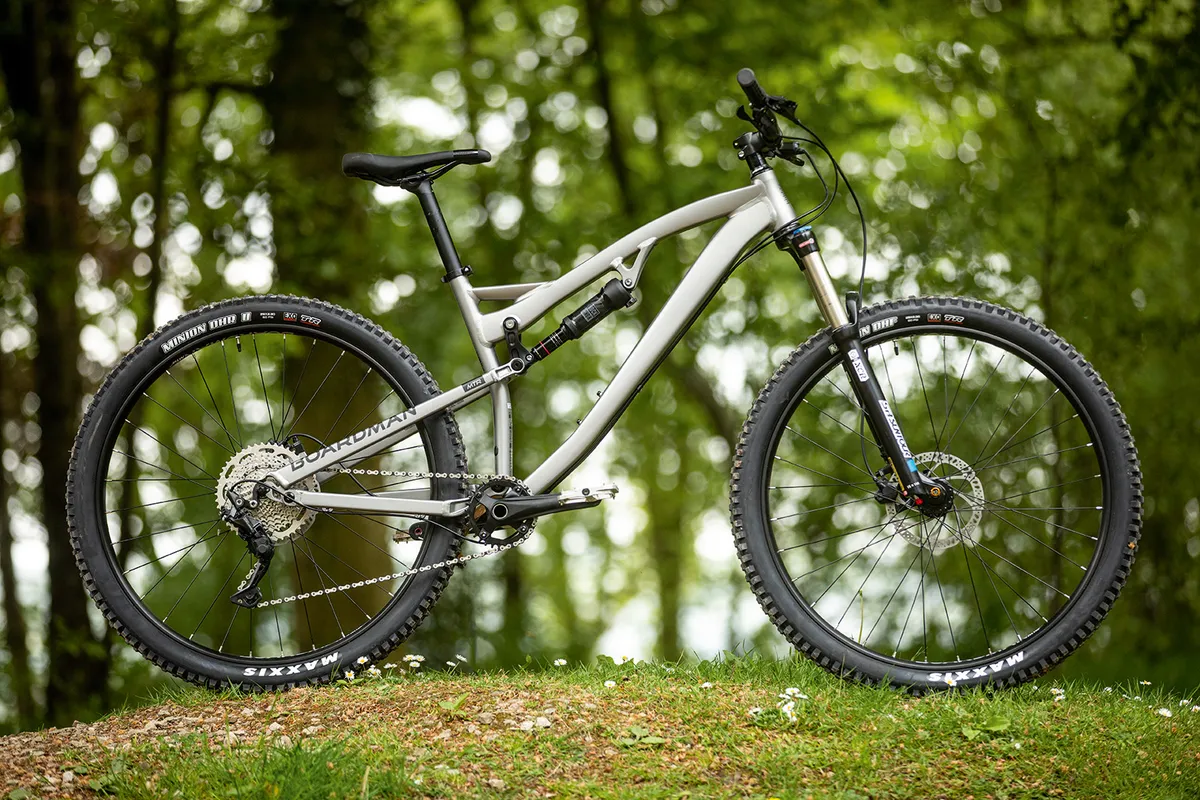
- Reliable rubber: The bike comes with tubeless-ready, dual-compound Maxxis Minion tyres, which are excellent for the price
- Bottling it: While you get frame mounts for a water bottle, you’ll require a side-entry cage and smaller bottle, to avoid it interfering with the shock
- In a jam: SR Suntour’s expanding Q-Loc thru-axle isn’t the most intuitive system and can get stuck inside the hub – something to bear in mind if you plan to regularly remove the front wheel to transport your bike
The Boardman MTR 8.6 is a full-suspension mountain bike with top-of-the-range geometry at a budget price. It pairs lesser-known kit, such as Tektro brakes and an SR Suntour fork, with instantly recognisable parts including top-tier Maxxis Minion tyres and an air-sprung RockShox shock.
Now the Calibre Bossnut is no longer on sale, the sorted Boardman MTR 8.6 is the go-to entry-level full-suspension mountain bike. It blends the trail-taming geometry of a pricier trail bike with a functional spec list at a great price.
Boardman MTR 8.6 specifications
- Sizes: S, M, L (tested), XL
- Weight: 14.4kg, large size without pedals
- Frame: 6061 aluminium alloy, 145mm travel
- Fork: SR Suntour XCR 34 LO-R DS Air, 140mm travel
- Shock: RockShox Deluxe Select
- Drivetrain: Shimano Deore with Shimano M5100 cranks (1x10)
- Wheelset: Boardman wheels
- Tyres: Maxxis Minion DHF EXO TR (f) and Minion DHR II EXO TR (r) 29x2.4in
- Brakes: Tektro HD-M285, 180/160mm rotors
- Bar: Boardman, 780mm
- Stem: Boardman, 45mm
- Seatpost: Boardman rigid
- Saddle: Boardman MTR
- Price: £1,150
Boardman MTR 8.6 geometry
| | S | M | L | XL |
|---|---|---|---|---|
| Seat angle (degrees) | 75.5 | 75.5 | 75.5 | 75.5 |
| Head angle (degrees) | 66 | 66 | 66 | 66 |
| Chainstay (mm) | 440 | 440 | 440 | 440 |
| Seat tube (mm) | 410 | 430 | 475 | 480 |
| Top tube (mm) | 598 | 615 | 638 | 655 |
| Head tube (mm) | 90 | 100 | 110 | 120 |
| Fork offset (mm) | 42 | 42 | 42 | 42 |
| Bottom bracket drop (mm) | 33 | 33 | 33 | 33 |
| Stack (mm) | 611 | 620 | 629 | 638 |
| Reach (mm) | 440 | 455 | 475 | 490 |
| Crank length (mm) | 170 | 170 | 170 | 170 |
| Handlebar width (mm) | 780 | 780 | 780 | 780 |
Boardman MHT 8.9 hardtail vs Boardman MTR 8.6 full-suspension
When Chris Boardman made his name as a winning road cyclist back in the 1980s, mountain bikes were still in their infancy and had no suspension beyond the air in their tyres.
Technology advanced rapidly, and since the mid-90s, two types of mountain bike have prevailed.
Hardtails have a rigid rear end for simplicity and pedalling efficiency, and a suspension fork to absorb bumps that would otherwise jiggle a rider’s arms and upper body.
Full-suspension bikes have a second spring and damper between the rider and the rear wheel, to both smooth out the ride and boost traction.
By general consensus, hardtails are more efficient for mile-munching riders who don’t want to sacrifice leg-power to rear-wheel movement. Full-suspension bikes offer extra cushioning and grip for more aggressive riders who are hitting big bumps at speed, landing jumps or railing corners.
There’s plenty of sense to this, but the reality is more nuanced. One look at modern XC World Cup bikes proves that the majority who are chasing pure off-road speed now choose a full-suspension mountain bike.
Money is no object to many racers, though, and top-level full-suspension XC bikes cost orders of magnitude more than £1k, so what do Boardman’s MTR and MHT each do best at a more down-to-earth price?
The frames
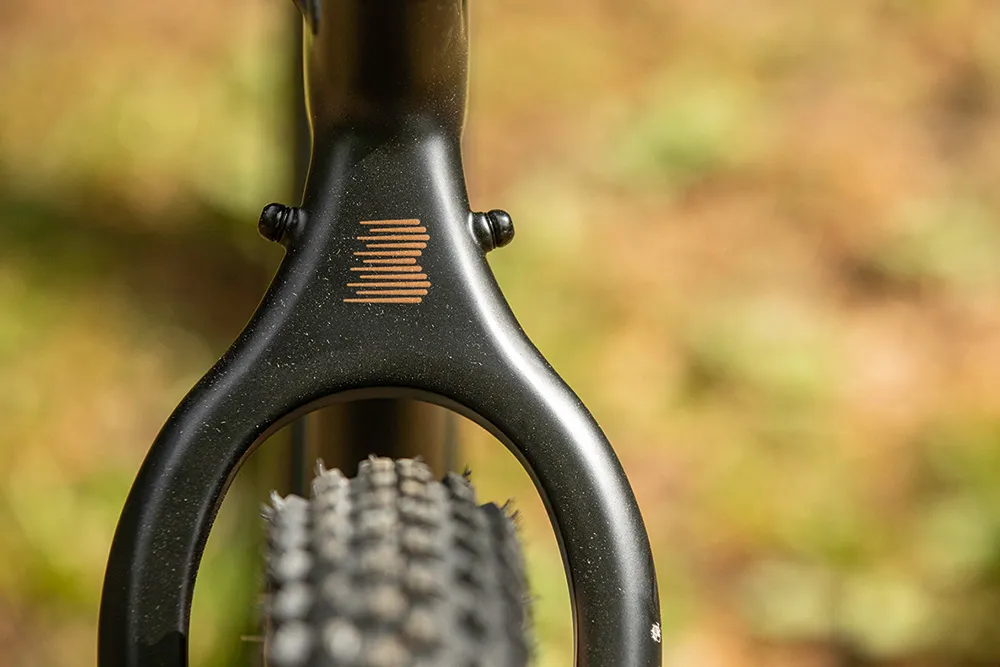
Beyond the fact that one frame has a shock bolted into it, the first thing you notice is that the MHT has a very clean-looking, smooth-welded front triangle, which could almost pass for carbon fibre from a distance.
Other leading brands use this construction technique where the top and down tubes are engineered precisely for a better join with the head tube.
The matching tube junctions not only look neater, but also reduce weld flex – one of the main ways an alloy frame can crack.
In contrast, the full-suspension MTR is chunkier and looks tougher (if a tad more clunky), with a 6-series alloy frame packing thick, beefy tubes joined by fishscale TIG welds.
Boardman claims both frames have modern geometry. As the MHT is designed to straddle XC and trail riding, it has been equipped with more relaxed steering, rather than the razor-sharp, edgy attitude of a pure-bred cross-country bike.
The MTR is still significantly slacker, though, with a considerably more raked-out 66-degree head angle, versus the hardtail’s more upright 68 degrees. This is an important metric in terms of handling, and results in lighter, more reactive steering on the MHT (something that’s also a consequence of a shorter wheelbase).
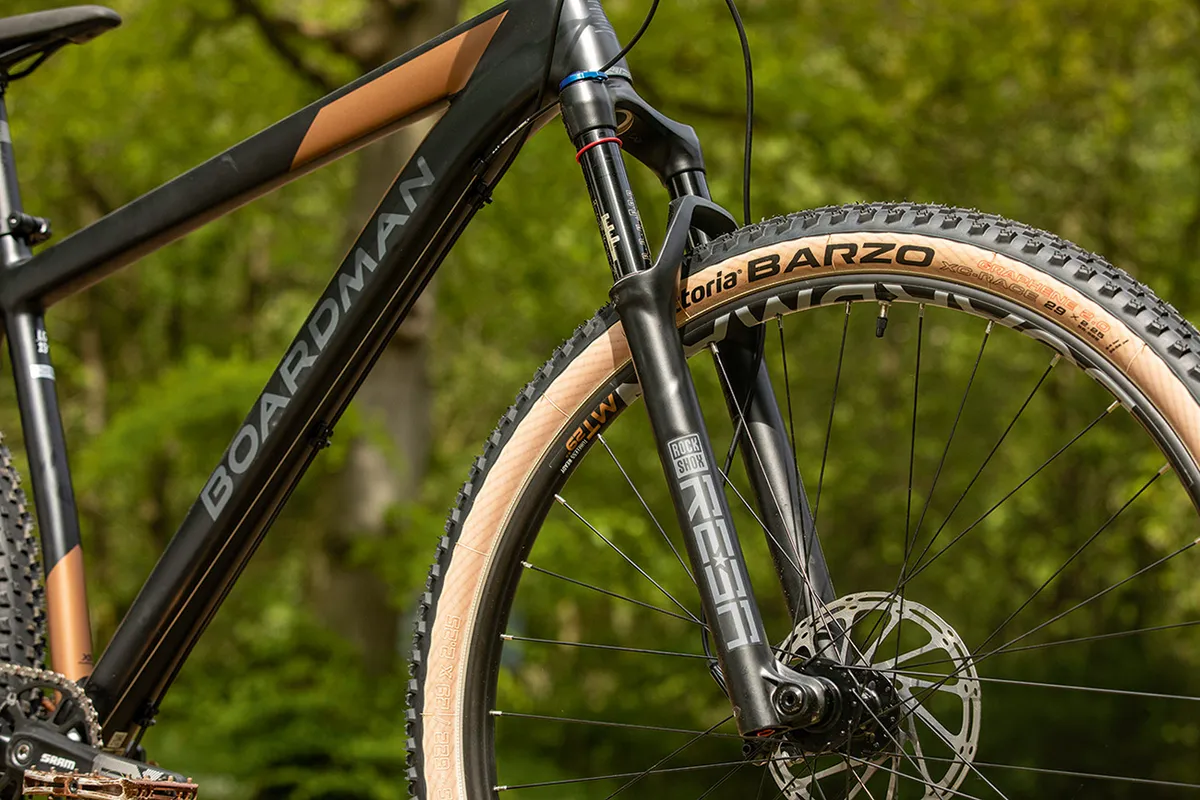
With the MTR not pivoting as much on the bottom of the front tyre and tending to keep pointing forwards, it can feel lazier at the handlebar, but as soon as speeds ramp up, its steering is way less prone to getting bounced off-line in the rough stuff or to tuck in suddenly on steeper downhill sections.
There’s also a lot more room to move around on the full-suspension bike. Looking at the reach figures of both frames (the horizontal distance from the centre of the bottom bracket to the centre-top of the head tube), which is the measurement that gives the best idea of how a bike will feel when you’re standing on the pedals, the size-large MHT puts your hands 441mm away from your feet while on the equivalent MTR that increases to 475mm.
This extra length makes the full-suspension more stable, while the shorter hardtail frame places more rider weight forward on the bike, for better balance when climbing out of the saddle.
At the back, the taller-top-tubed hardtail takes advantage of not having any rear travel (and the associated potential for increased pedal strikes) with a lower BB height, which gets your feet closer to the ground for extra stability and better cornering.
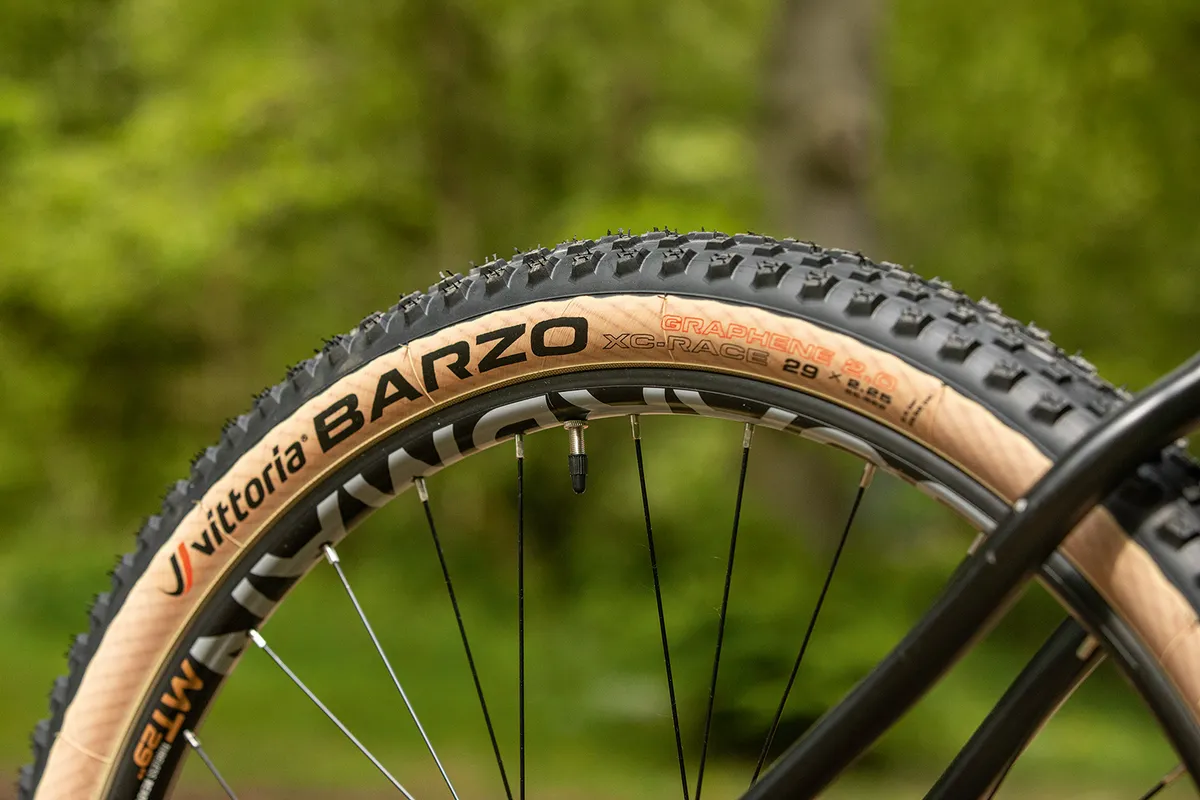
It’s still not as low as on some hardtails, but strikes a good balance, especially when combined with chainstays that are 5mm shorter than the full-suspension bike's.
These move the rear wheel closer to the rider, boosting the MHT’s nimble, manoeuvrable ride feel.
The MTR frame delivers 145mm of rear-wheel travel via a tried-and-tested four-bar linkage.
Favoured by top brands including Specialized and Canyon, this design uses a secondary pivot on the chainstays to keep the suspension active when you need it most – when grabbing the brakes on your way down the steepest tracks. Sealed bearings are specced throughout for improved sensitivity.
The rear end’s squared-off tubing uses the latest 148mm-wide Boost hub spacing (which allows room for a stronger wheel with wider spoke brace angle). However, you can spot where Boardman has saved cash for the suspension budget – you get an old-fashioned quick-release (QR) skewer, rather than the MHT’s stiffer and more secure bolt-thru axle.
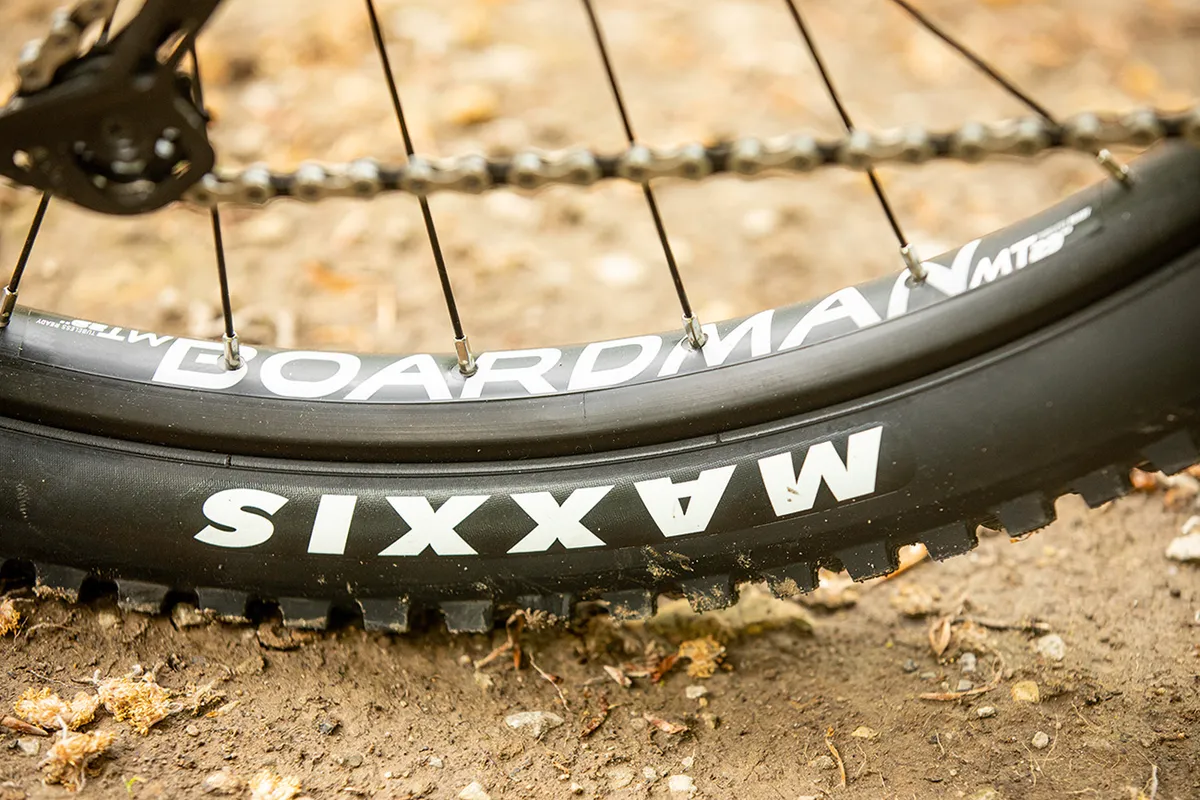
This money has been spent well, on a long-stroke RockShox shock. It’s driven by a rocker-link mounted to the top tube, with just enough space underneath for a water bottle.
However, because the bottle cage bosses are positioned higher up the down tube, you can’t fit a full-size bottle as on the MHT.
There’s no need for a strengthening gusset where the massive top and down tubes meet the head tube, but there is one bracing the seat tube, to allow for more standover clearance, so the top tube doesn’t get in the way when pulling shapes. One thing that does get in the way on both Boardmans is the saddle.
Neither bike comes with a dropper seatpost, which would allow you to drop the saddle out of the way on descents with the press of a lever; this is an obvious first upgrade.
The kit
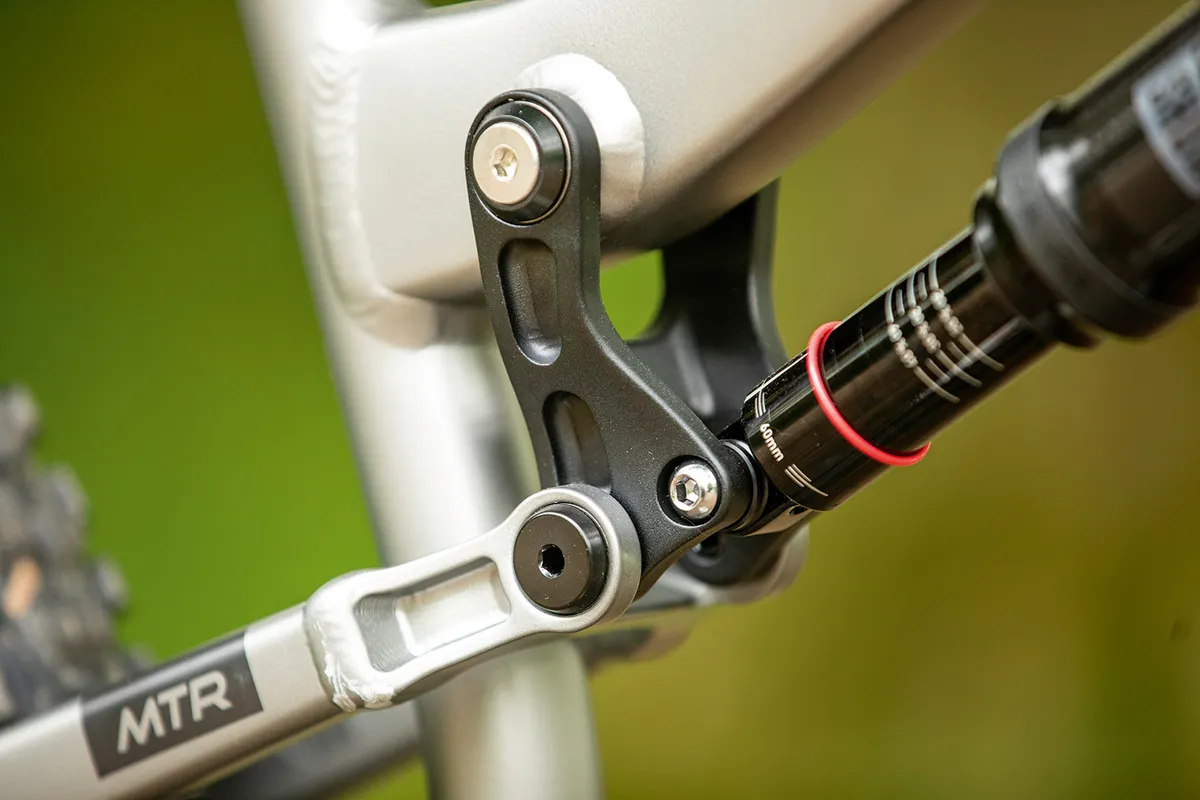
Both bikes use an air-sprung fork that’s easy to tune to the rider’s weight. The MHT 8.9’s RockShox Reba RL has 20mm less travel than the cheaper SR Suntour XCR 34 on the MTR 8.6, but you’ll be hard-pressed to notice any difference. The Reba’s action is significantly smoother and more controlled, sucking up bumps and recomposing for the next hit.
While the Suntour fork is sophisticated enough to have lighter, thicker alloy legs, rather than the skinny steel ones found on plenty of cheap full-suspension bikes, its QR axle is very fiddly, which isn’t ideal if you have to regularly remove the front wheel.
Both offer the same adjustment options – a rebound-damping dial plus a progressive low-speed compression damping ‘lockout’, to firm up the fork so it doesn’t bob when pedalling hard on tarmac or smoother fireroads.
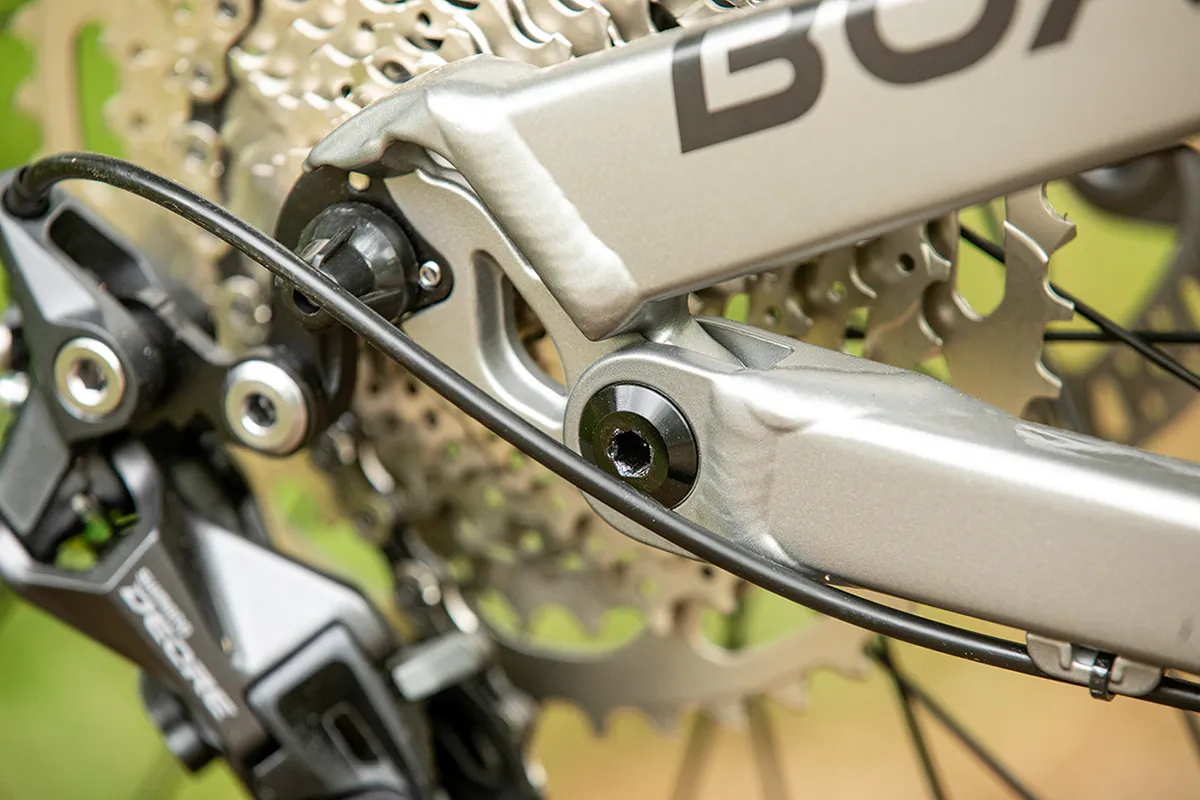
The only shock here is a custom-tuned RockShox Deluxe, which (at this price point) is limited to rebound-damping adjustment only. We ended up running this fully open, since Boardman has skewed the damping range too much towards a slow return.
If you add more than a few clicks of rebound, the shock gets really bogged down. This will likely be an issue for lighter riders running lower air pressures, which will leave the fork unable to bounce back into position fast enough to handle consecutive impacts.
When you need to slow down, the MHT 8.9’s SRAM Level T brakes are more refined and powerful than the MTR 8.6’s Tektro HD-M285s, although neither offers huge top-end stopping power.
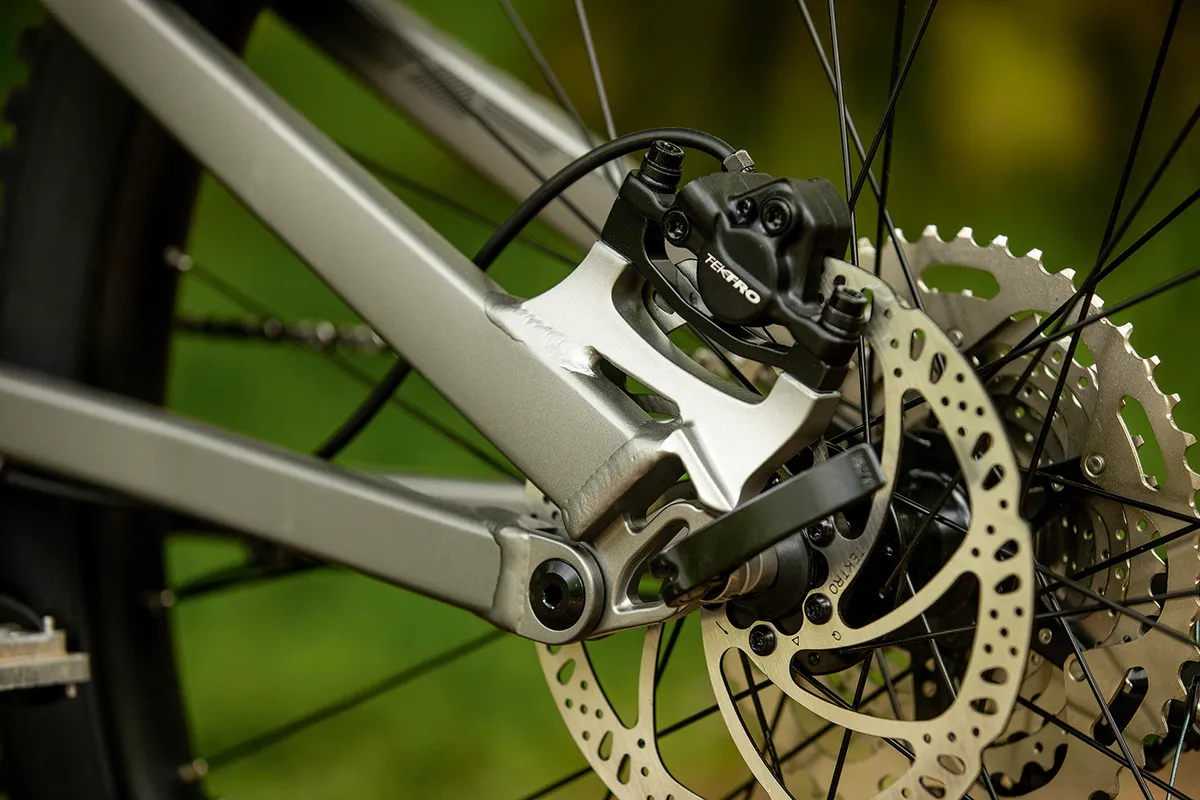
The hardtail’s better spec also includes higher-quality Formula hubs and lighter, more sculpted Boardman rims. These are fitted with fast-rolling Vittoria Barzo tyres made from the brand’s priciest, quad-compound graphene rubber blend.
While these roll considerably faster than the Maxxis Minions mounted on the full-suspension's wider (and heavier) wheels, once you ride anywhere where grip improves confidence and traction, the Maxxis tyres are leagues ahead.
This is even more true if you chuck moisture or off-camber roots into the mix.
Both bikes use narrow-wide chainrings to stabilise their chain, but the MTR 8.6’s Shimano Deore drivetrain is missing two shifter clicks compared to the 12-speed SRAM SX Eagle on the MHT 8.9.
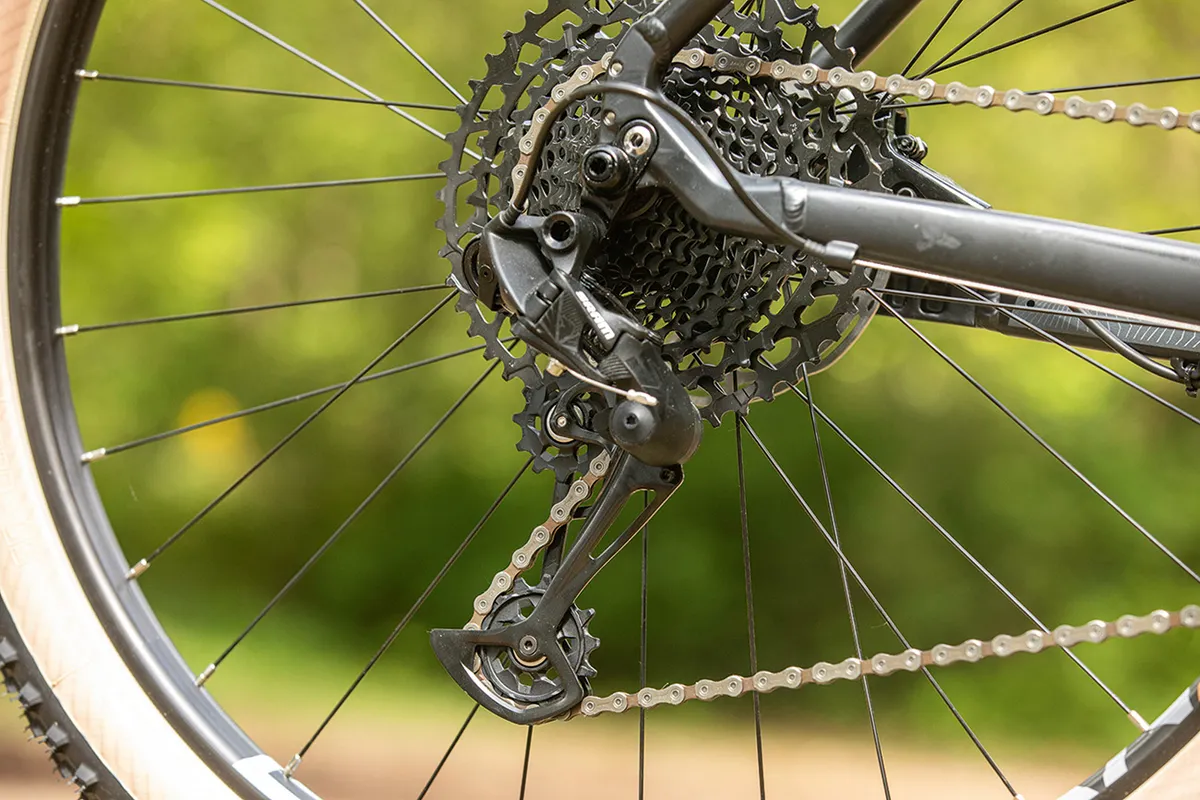
Only having 10 gears, compared to a dozen (including a massive, incline-easing 50t biggest cassette sprocket), sounds like a big deal, but the Deore setup is smoother and more positive-feeling overall.
Plus, no testers had an issue with excessive jumps between gears or trouble scaling climbs with the full-suspension bike's 46t biggest cog.
In fact, this component choice looks like a lesson in good budgeting. The better-quality 10-speed drivetrain, with quality Shimano HollowTech BB and stiff Deore crank arms, trumps the shifting of the 12-speed SRAM setup. The SX cranks feel a bit flexy when bolted into a chassis with a solid rear end, especially if you run big flat pedals.
The ride
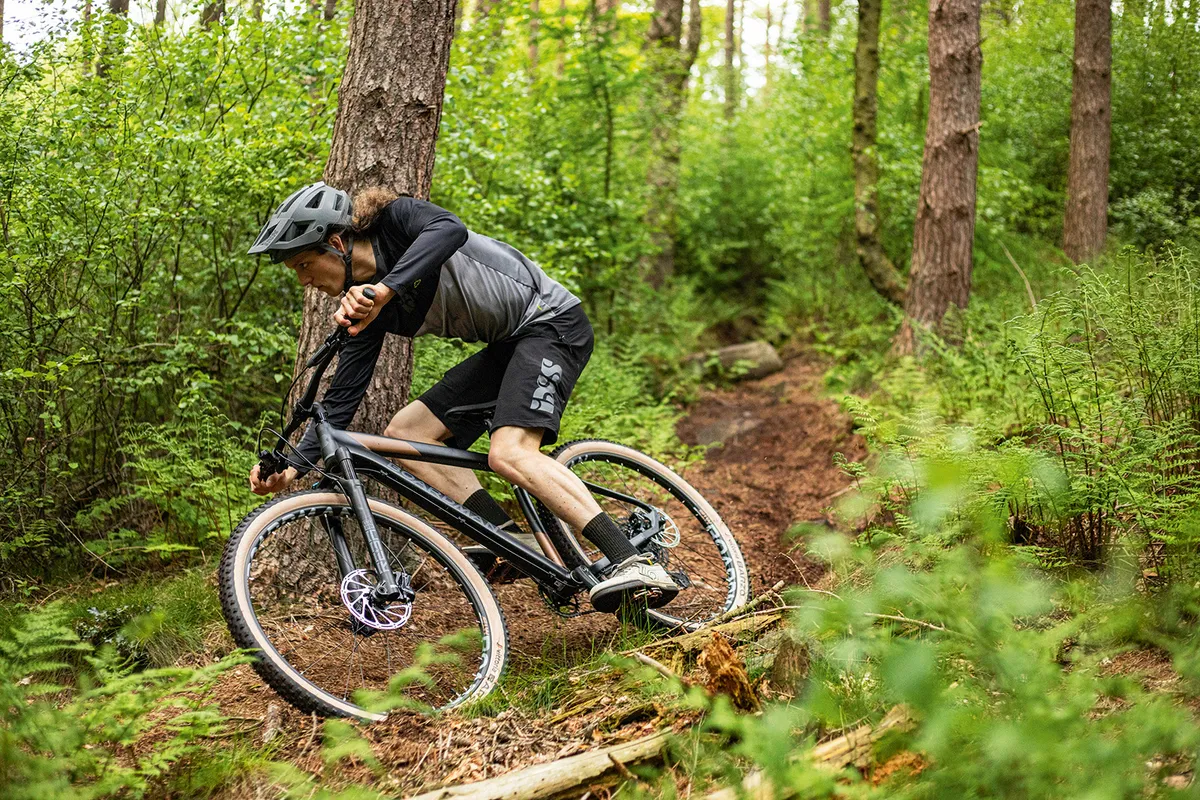
The MHT 8.9 has an impressively smooth ride – this is definitely not a rattle-your-fillings, rock-hard, cheap-feeling alloy hardtail.
Even across pretty chopped-up trail surfaces and repeated roots, the frame follows the route traced by the smooth Reba fork. As long as you run the Vittoria tyres at pressures not too much over 20psi, there’s no excessive trail vibration or chatter to jiggle your vision or make your hands and arms fatigue easily.
On gravel bridleways and smoother trail-centre surfaces, the small, pointy tread blocks of the Barzo tyres help you really buzz along, and they also cut into loam and dirt nicely on more natural dry trails.
Throw in some bark-stripped roots and dusty rocks, though, and there’s more wheel-spinning when climbing and a much less sure-footed feel overall than with the MTR 8.6’s 145mm of rear suspension and Maxxis tyres.
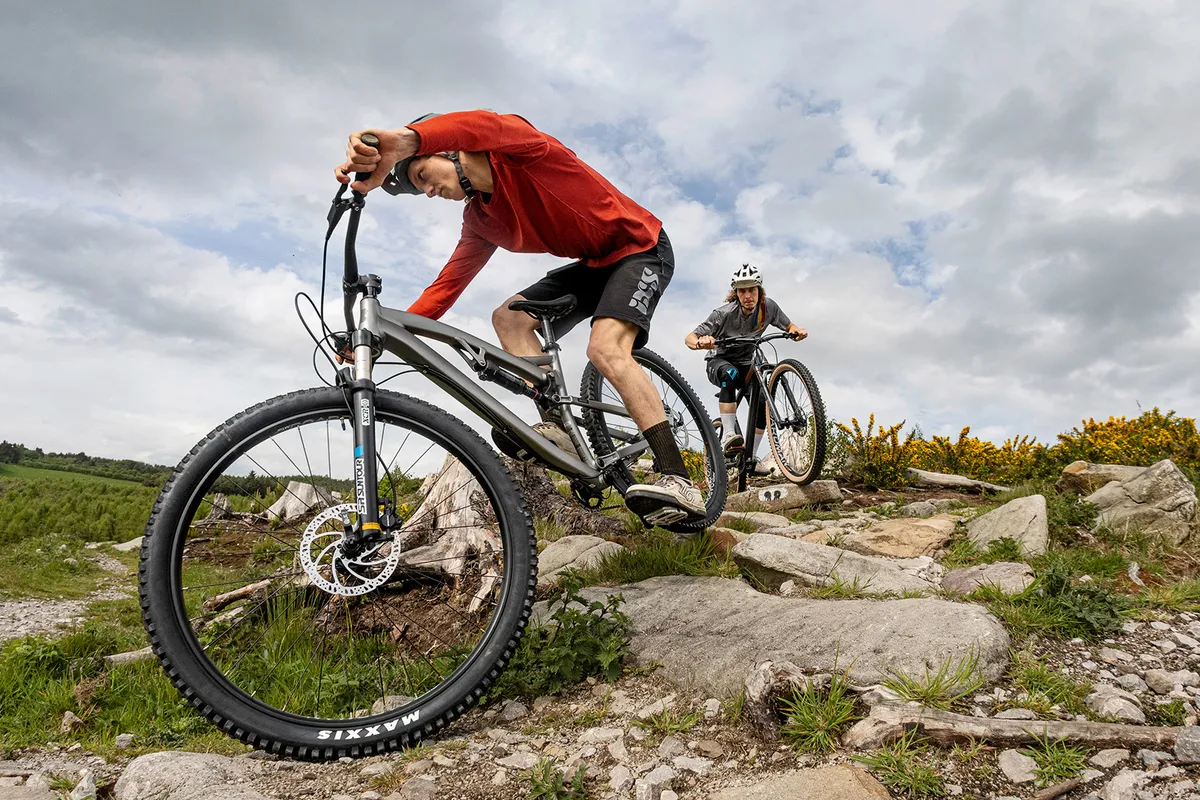
This means the hardtail’s speed advantage on flatter trails isn’t as clear-cut as you might expect. The full-suspension bike often gets you across little techy sections without dabbing, where the MHT 8.9 bobbles and hunts for traction.
While a 68-degree head angle definitely isn’t crazy-steep for a trail/XC hardtail, the MTR 8.6’s mellower steering feels much calmer and more neutral through tricky sections.
This is on top of the hardtail generally feeling less planted and stable, and a bit more hectic on rougher trails.
Riding at a local trail centre where the tracks are really eroded, this was evident in how, even with a superior fork, the MHT 8.9 was less capable of staying smooth when threading through niggly trail passages.
We’re not talking about bombing downhill, either, just maintaining some fluidity and rhythm through lumpy, rocky sections, where you’d expect the lighter steed to find pace more easily. This isn’t the case on smooth bridleways or tarmac, however, where the hardtail feels lighter and has more zip than the full-suspension bike.
For what we’d call ‘proper’ mountain biking (anything that a gravel bike can’t handle), though, the MTR 8.6 is in its element and is calmness personified.
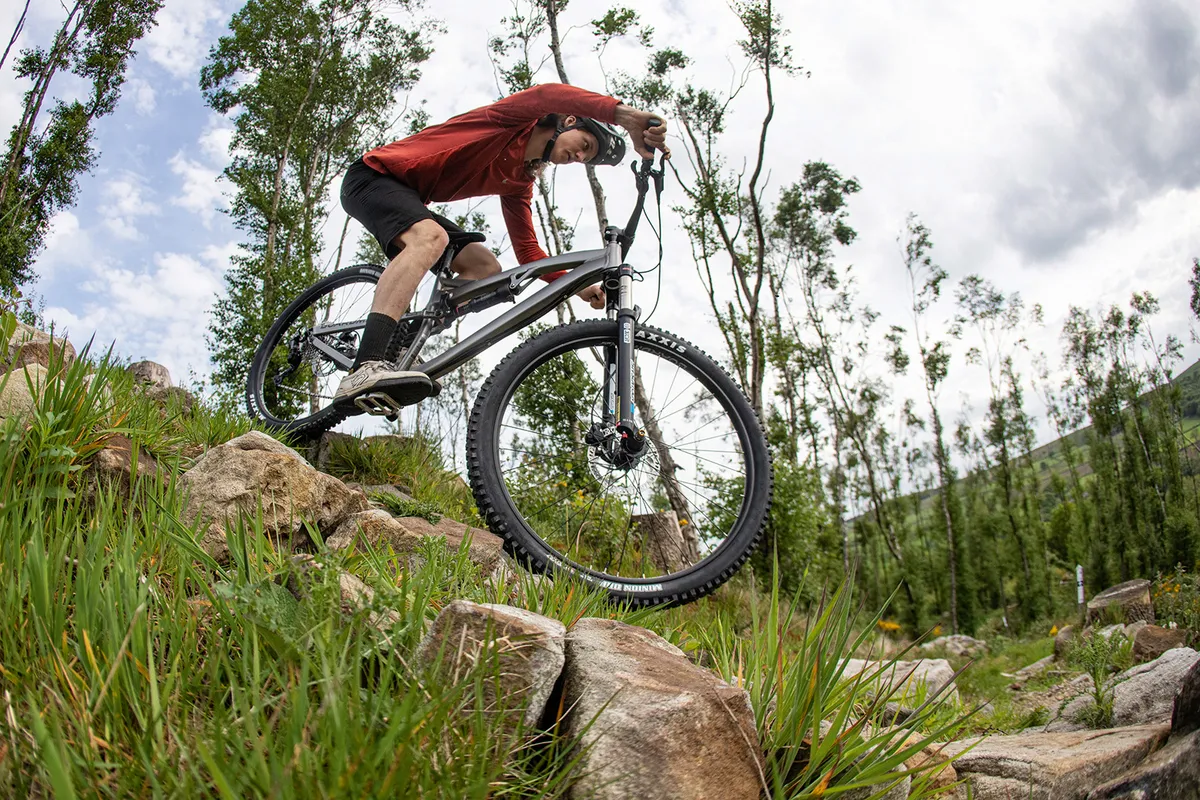
The MTR 8.6 rides much like a more expensive trail bike and smooths out pretty hefty lumps and bumps, giving you the confidence to get off the brakes and find some flow.
The full-suspension bike's pedalling manners are good, too, allowing even power delivery when you want to inject some pace or wind back to the top of the hill without too much drama.
Its suspension is a little less refined than on top-tier machines, and can actually feel too smooth at times and a little dull on the ground. Hard-charging riders may also find the frame a little flexy and eager to smash through the first part of its travel if you’re really pushing it.
For most new or intermediate riders, however, the rear shock being soft-off-the-top gives good grip and comfort over hard sections. With the functional front suspension and kicked-back geometry, it brings extra reaction time when picking up the pace, making it way easier to have fun and find your personal limits.
This, ultimately, is the reason why we’d choose the full-suspension from this pair every time. After all, messing about in corners and over lumps and berms is what mountain biking is all about for most riders.
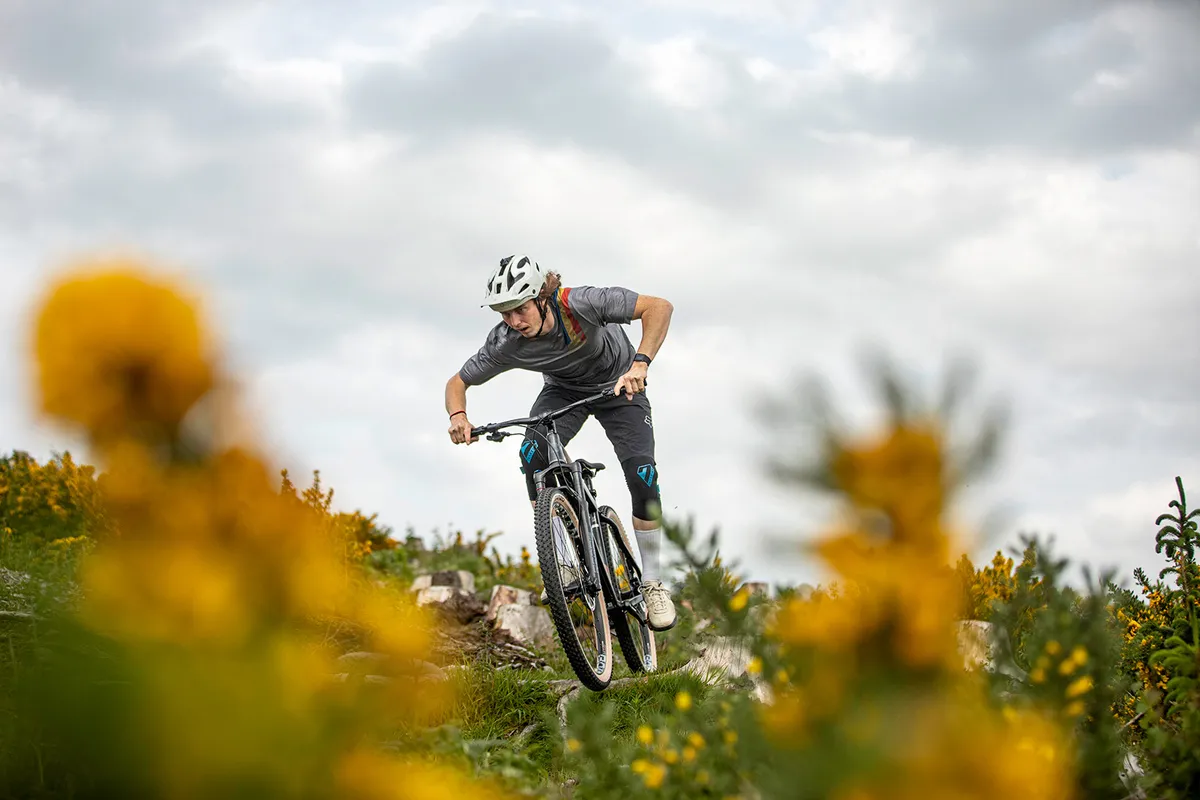
The MTR 8.6’s rear suspension and slacker geometry enable you to get stuck in and play on proper tracks with tons more confidence and security than the sharper-feeling, more jangly and traction-compromised ride of the MHT 8.9.
The full-suspension bike is £100 more than its better-dressed sibling and isn’t perfect, but then no bike for this cash is ever going to be.
It’s genuinely hard to find a budget full-suspension competitor close to offering such trail-taming geometry and as dialled a ride for this price. That's especially true now Calibre’s award-winning Bossnut is no longer available.
Full-suspension vs hardtail mountain bike price guide
Below, we give a rough guide to what to expect from full-suspension and hardtail mountain bikes at different prices.
Under £1,000 / $1,000 / AU$1,300
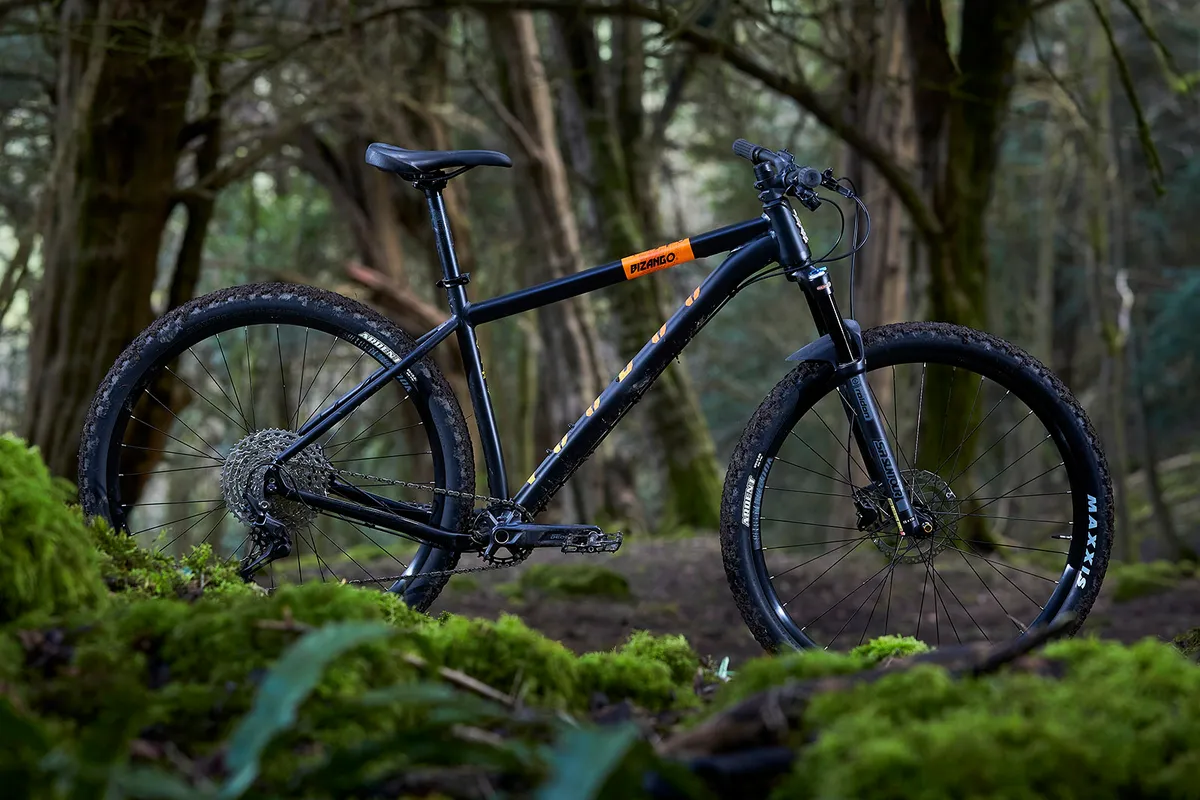
If you’re serious about hitting the trails on a mountain bike for around £1,000, you’re better off with a hardtail. Sure, for this money you may be able to find a used full-suspension mountain bike, but anything new will have far too many compromises for the intended purpose.
If purchasing new, buy from a specialist bike shop. Our basic rule of thumb is: if they sell toilet paper, it’s not the place to buy a quality bike.
From £1,000 / US$1,000 / AU$1,300 to £1,500 / $1,500 / AU$1,600
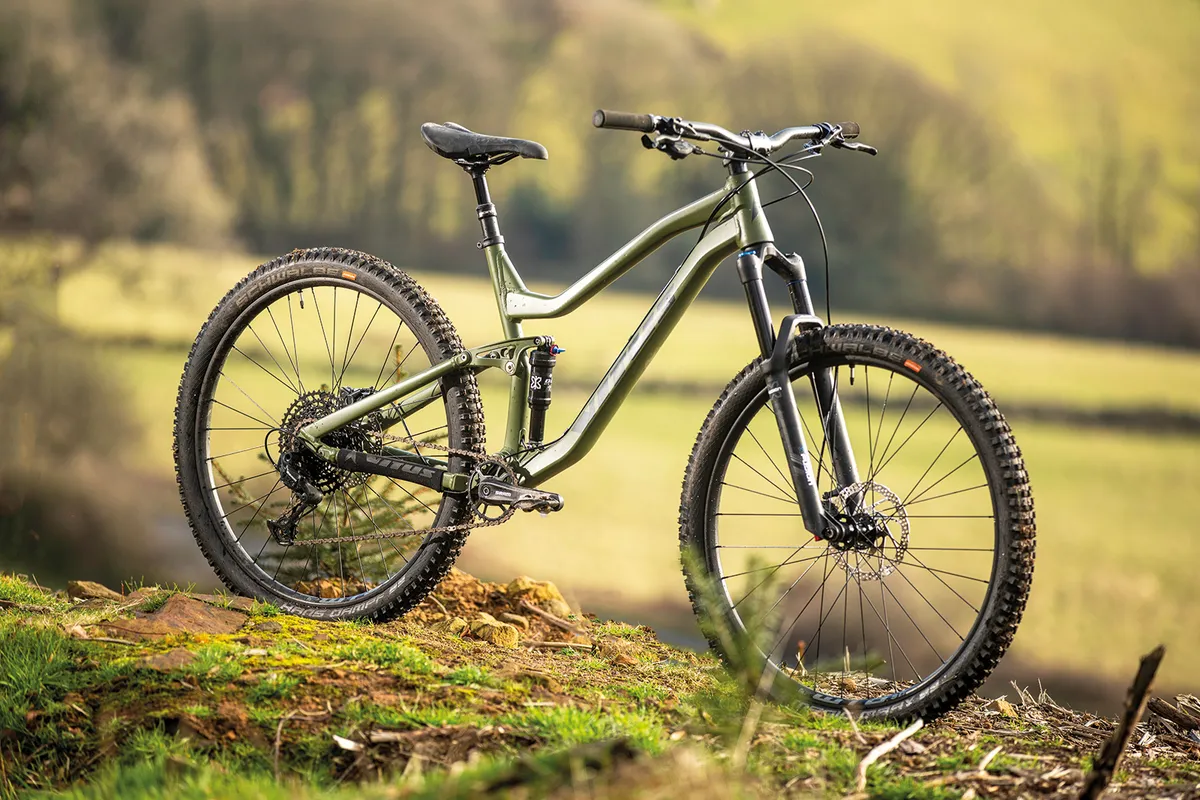
The best mountain bikes under £1,500 see full-suspension start to become available.
However, many large brands who sell through bike shops can't offer a competitive option here. It’s best to stick with their hardtail ranges. Exceptions, such as from Giant and Jamis, are few and far between.
Some bargains are possible from consumer-direct sales brands, though – if you can forgo face-to-face service and support. The likes of Polygon, Vitus, Calibre and Fezzari are worth considering.
From £1,500 / US$1,500 / AU$1,600 to £2,200 / $2,000 / AU$2,200
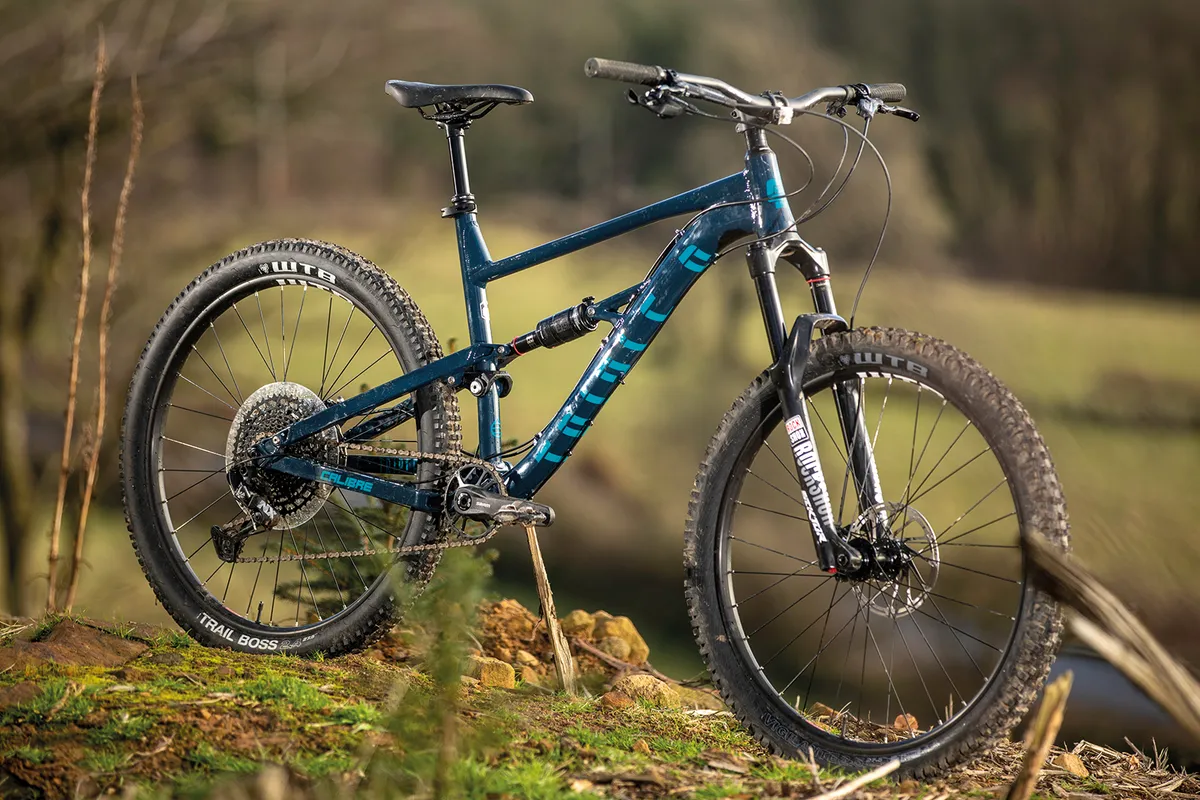
If you have around £2,000 to spend on a mountain bike, the big brands such as Giant, Merida, Trek and Specialized offer full-suspension frames with lower-grade components.
These will do the job if you’re looking to ride on technical terrain and keep up with your mates on similar (but perhaps more expensive) bikes. Just beware that there are some component compromises, especially in the suspension quality, compared to an equivalent-priced hardtail.
From £2,200 / US$2,000 / AU$2,200 to £3,000 / $3,000 / AU$3,000
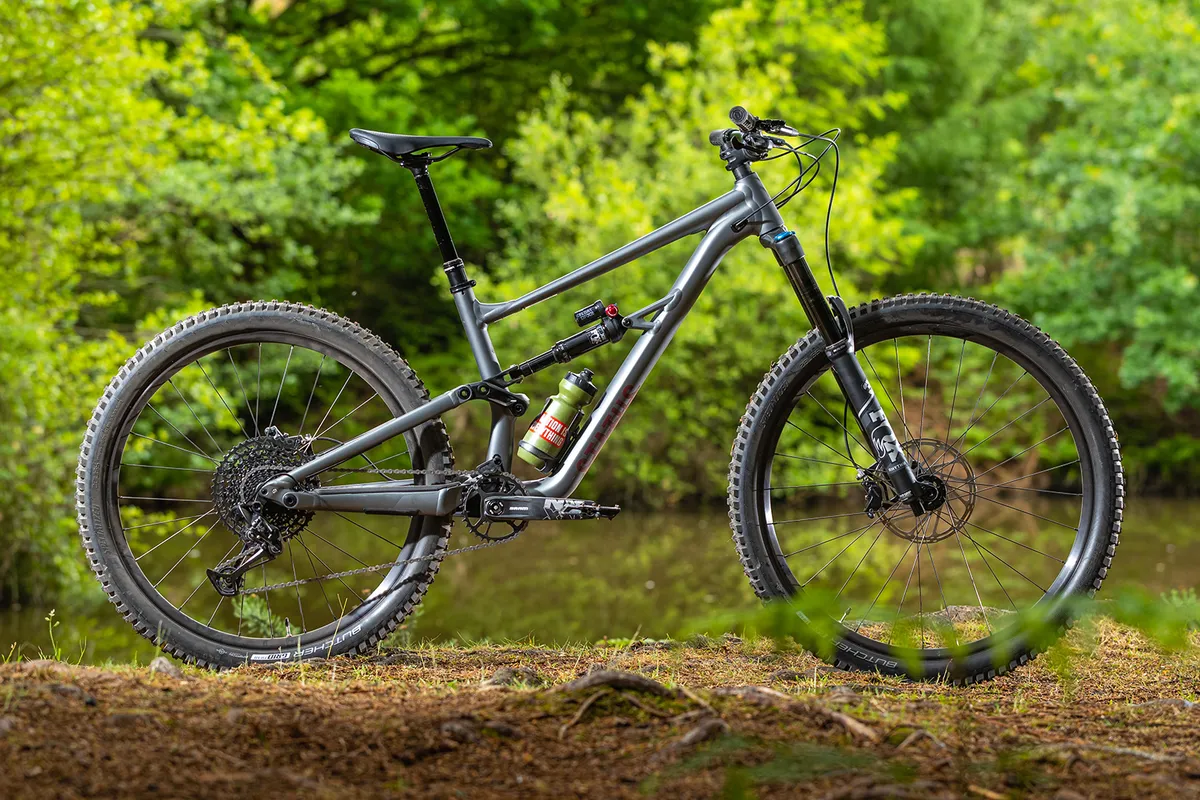
If you can afford one of the best mountain bikes under £3,000, here full-suspension bikes receive higher-quality components. The big marque options start to feature branded suspension, including suspension lockouts front and rear.
Here, the bikes are much heavier than the equivalently priced hardtail, but that weight comes with confidence on the trail.
Decide whether you want to race or not. If cross-country racing, a carbon hardtail at this price is going to be more efficient, more reliable and far lighter. For all other forms of riding, the full-suspension mountain bike would be our pick.
From £3,000+ / US$3,000+ / AU$3,000 +
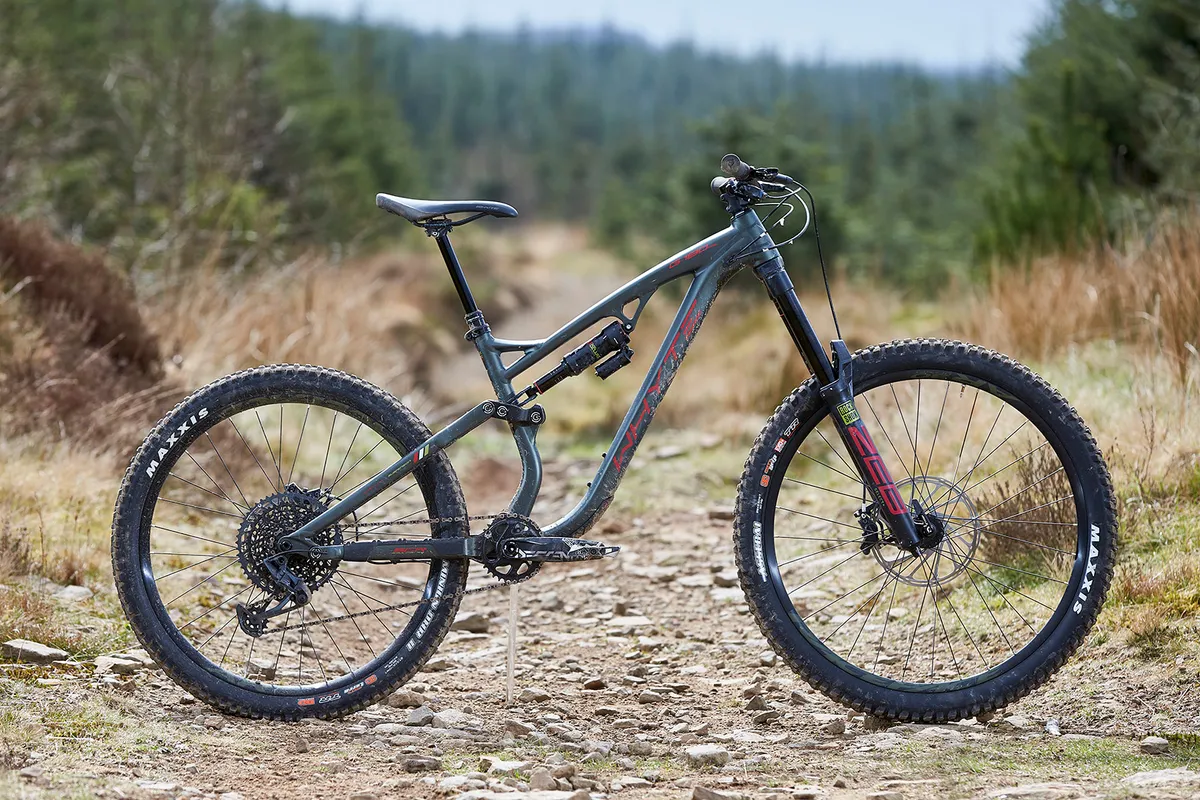
As with the previous price range, you’re now getting into upper-level components. You’d expect carbon if it’s a hardtail, but for those not racing – go for the full-suspension.
